University Report: Sustainable Tourism Development in the Philippines
VerifiedAdded on 2020/07/22
|25
|5229
|35
Report
AI Summary
This report examines the sustainable tourism development in the Philippines, focusing on stakeholder benefits derived from tourism planning and the advantages and disadvantages of public-private partnerships. It explores the significance of interactive planning systems at various levels (international, regional, national, and local) and details methods for measuring the impact of tourism, such as STEAM and PPP models. The report also addresses sustainability in tourism development and methods for resolving conflicts to ensure future well-being, providing a comprehensive overview of the factors influencing tourism in the Philippines. The report provides an analysis of the benefits of stakeholders involved in the development of tourism, the advantage and disadvantage of private/public partnership, characteristics of tourism development planning at different levels, significance of interactive planning systems, methods for measuring impact of tourism, sustainability tourism development and methods of resolving conflicts for ensuring future well-being.
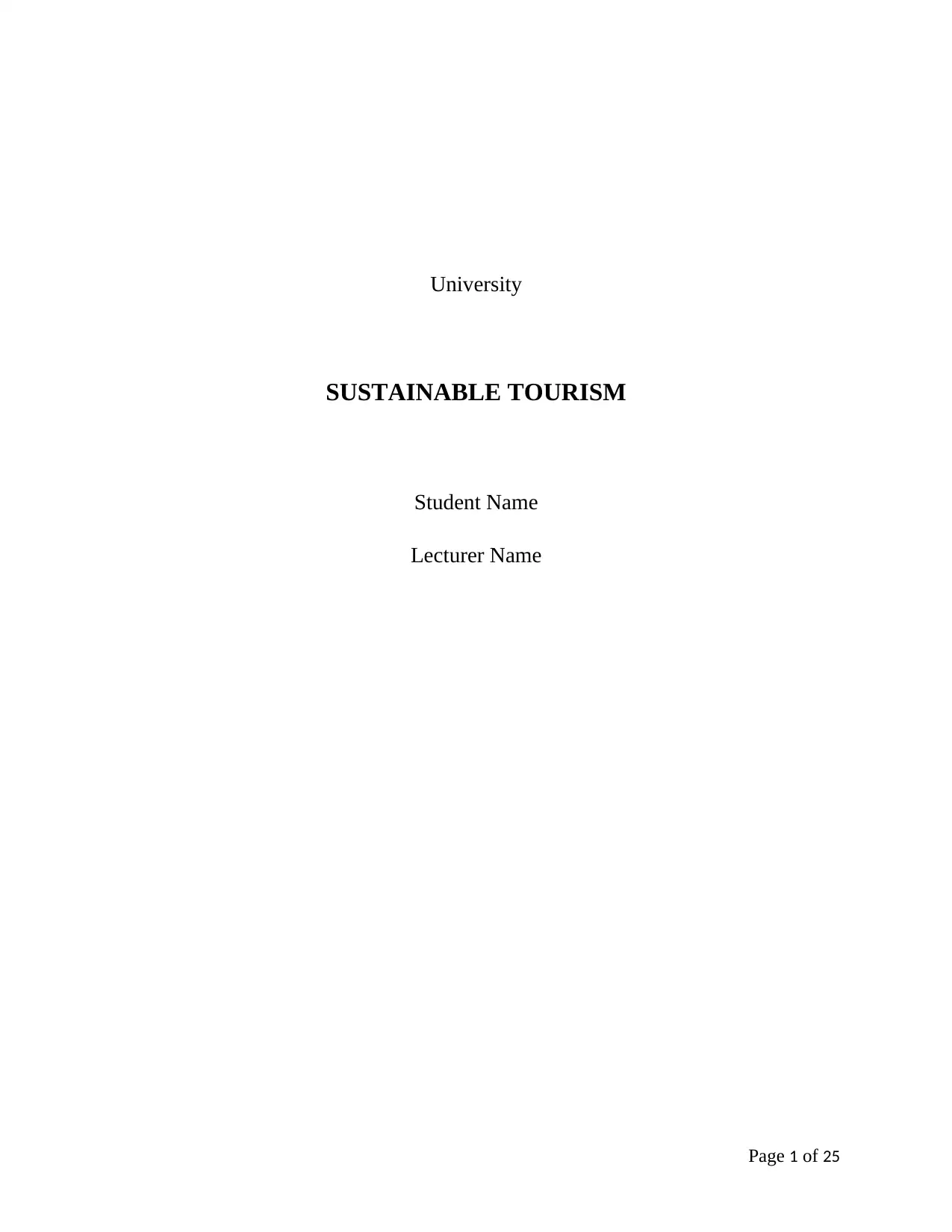
University
SUSTAINABLE TOURISM
Student Name
Lecturer Name
Page 1 of 25
SUSTAINABLE TOURISM
Student Name
Lecturer Name
Page 1 of 25
Paraphrase This Document
Need a fresh take? Get an instant paraphrase of this document with our AI Paraphraser
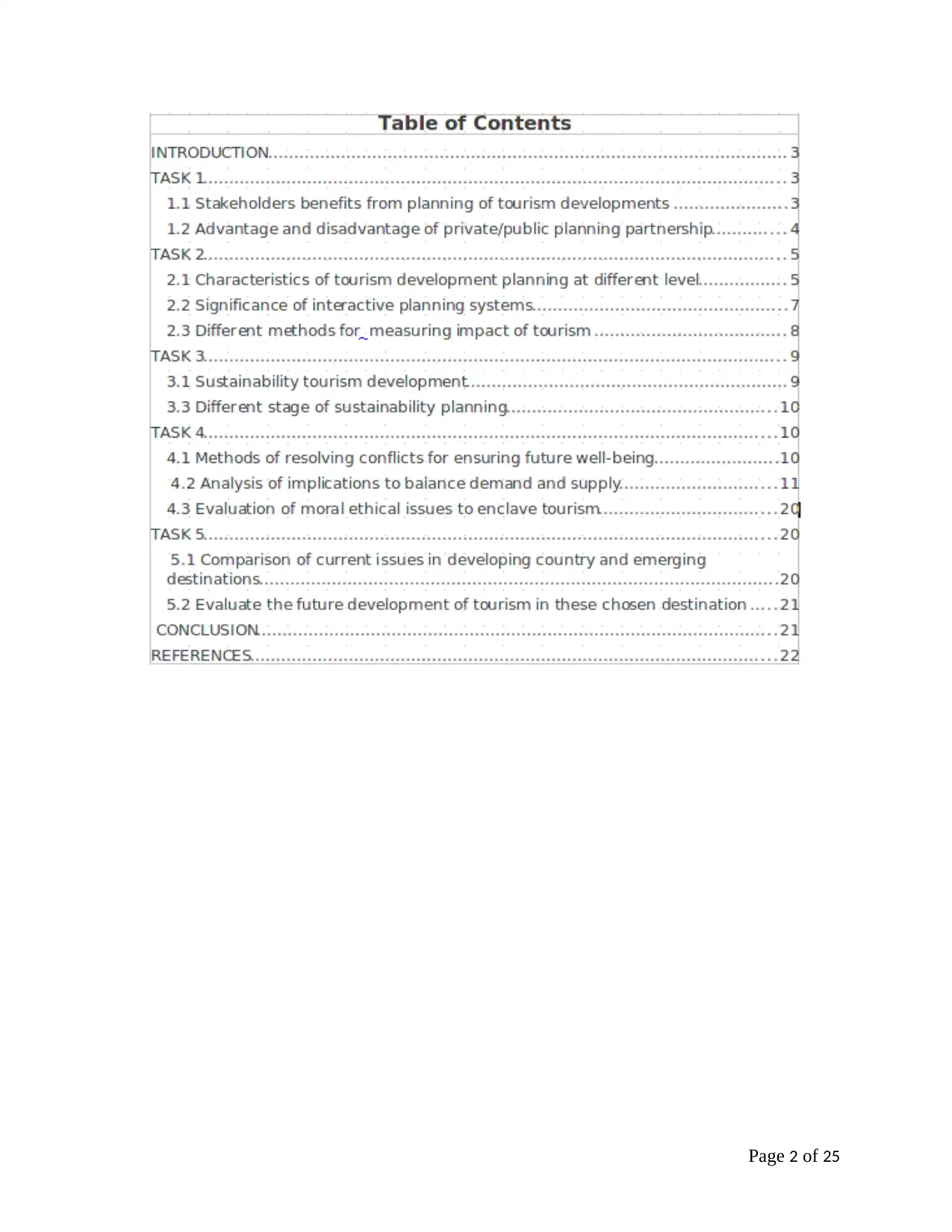
Page 2 of 25
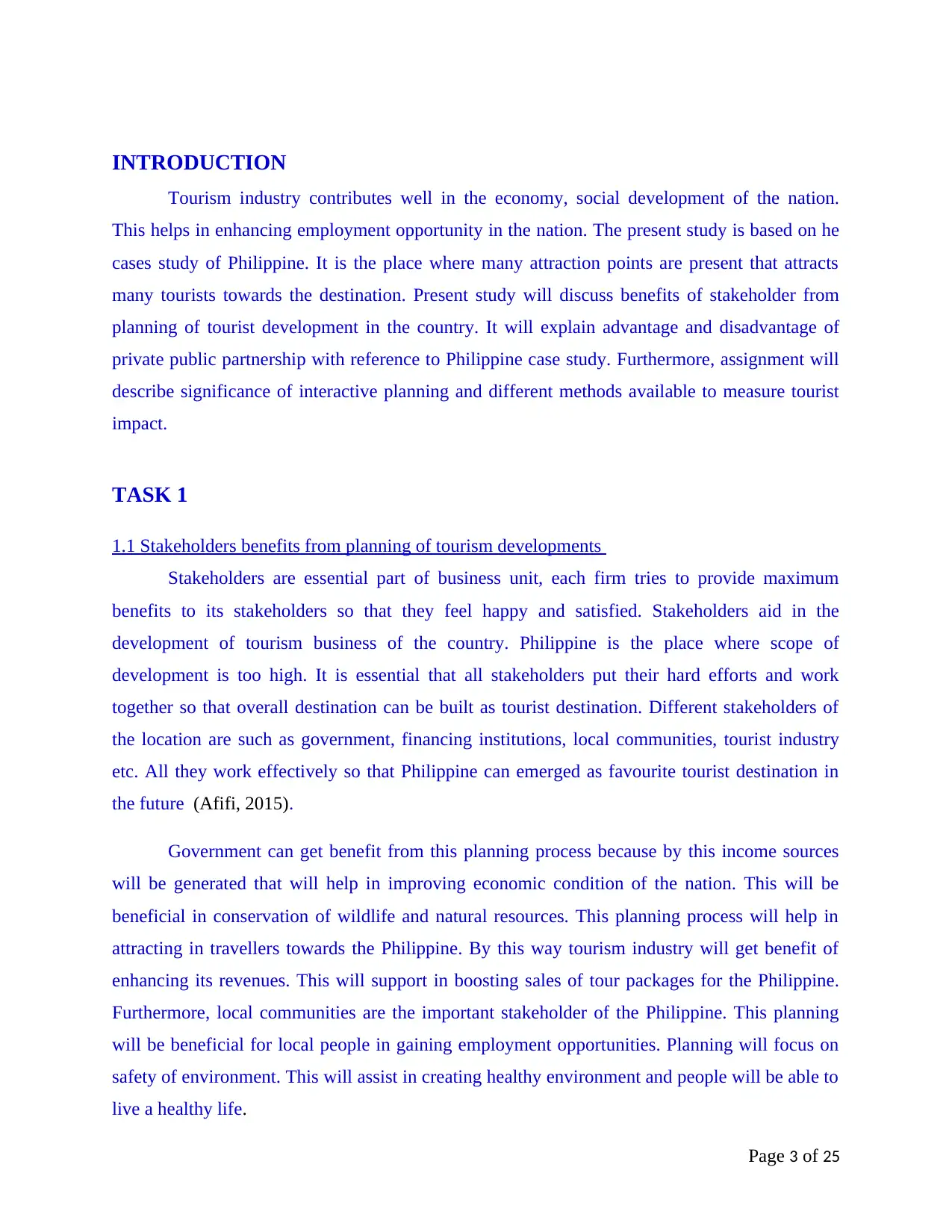
INTRODUCTION
Tourism industry contributes well in the economy, social development of the nation.
This helps in enhancing employment opportunity in the nation. The present study is based on he
cases study of Philippine. It is the place where many attraction points are present that attracts
many tourists towards the destination. Present study will discuss benefits of stakeholder from
planning of tourist development in the country. It will explain advantage and disadvantage of
private public partnership with reference to Philippine case study. Furthermore, assignment will
describe significance of interactive planning and different methods available to measure tourist
impact.
TASK 1
1.1 Stakeholders benefits from planning of tourism developments
Stakeholders are essential part of business unit, each firm tries to provide maximum
benefits to its stakeholders so that they feel happy and satisfied. Stakeholders aid in the
development of tourism business of the country. Philippine is the place where scope of
development is too high. It is essential that all stakeholders put their hard efforts and work
together so that overall destination can be built as tourist destination. Different stakeholders of
the location are such as government, financing institutions, local communities, tourist industry
etc. All they work effectively so that Philippine can emerged as favourite tourist destination in
the future (Afifi, 2015).
Government can get benefit from this planning process because by this income sources
will be generated that will help in improving economic condition of the nation. This will be
beneficial in conservation of wildlife and natural resources. This planning process will help in
attracting in travellers towards the Philippine. By this way tourism industry will get benefit of
enhancing its revenues. This will support in boosting sales of tour packages for the Philippine.
Furthermore, local communities are the important stakeholder of the Philippine. This planning
will be beneficial for local people in gaining employment opportunities. Planning will focus on
safety of environment. This will assist in creating healthy environment and people will be able to
live a healthy life.
Page 3 of 25
Tourism industry contributes well in the economy, social development of the nation.
This helps in enhancing employment opportunity in the nation. The present study is based on he
cases study of Philippine. It is the place where many attraction points are present that attracts
many tourists towards the destination. Present study will discuss benefits of stakeholder from
planning of tourist development in the country. It will explain advantage and disadvantage of
private public partnership with reference to Philippine case study. Furthermore, assignment will
describe significance of interactive planning and different methods available to measure tourist
impact.
TASK 1
1.1 Stakeholders benefits from planning of tourism developments
Stakeholders are essential part of business unit, each firm tries to provide maximum
benefits to its stakeholders so that they feel happy and satisfied. Stakeholders aid in the
development of tourism business of the country. Philippine is the place where scope of
development is too high. It is essential that all stakeholders put their hard efforts and work
together so that overall destination can be built as tourist destination. Different stakeholders of
the location are such as government, financing institutions, local communities, tourist industry
etc. All they work effectively so that Philippine can emerged as favourite tourist destination in
the future (Afifi, 2015).
Government can get benefit from this planning process because by this income sources
will be generated that will help in improving economic condition of the nation. This will be
beneficial in conservation of wildlife and natural resources. This planning process will help in
attracting in travellers towards the Philippine. By this way tourism industry will get benefit of
enhancing its revenues. This will support in boosting sales of tour packages for the Philippine.
Furthermore, local communities are the important stakeholder of the Philippine. This planning
will be beneficial for local people in gaining employment opportunities. Planning will focus on
safety of environment. This will assist in creating healthy environment and people will be able to
live a healthy life.
Page 3 of 25
⊘ This is a preview!⊘
Do you want full access?
Subscribe today to unlock all pages.

Trusted by 1+ million students worldwide
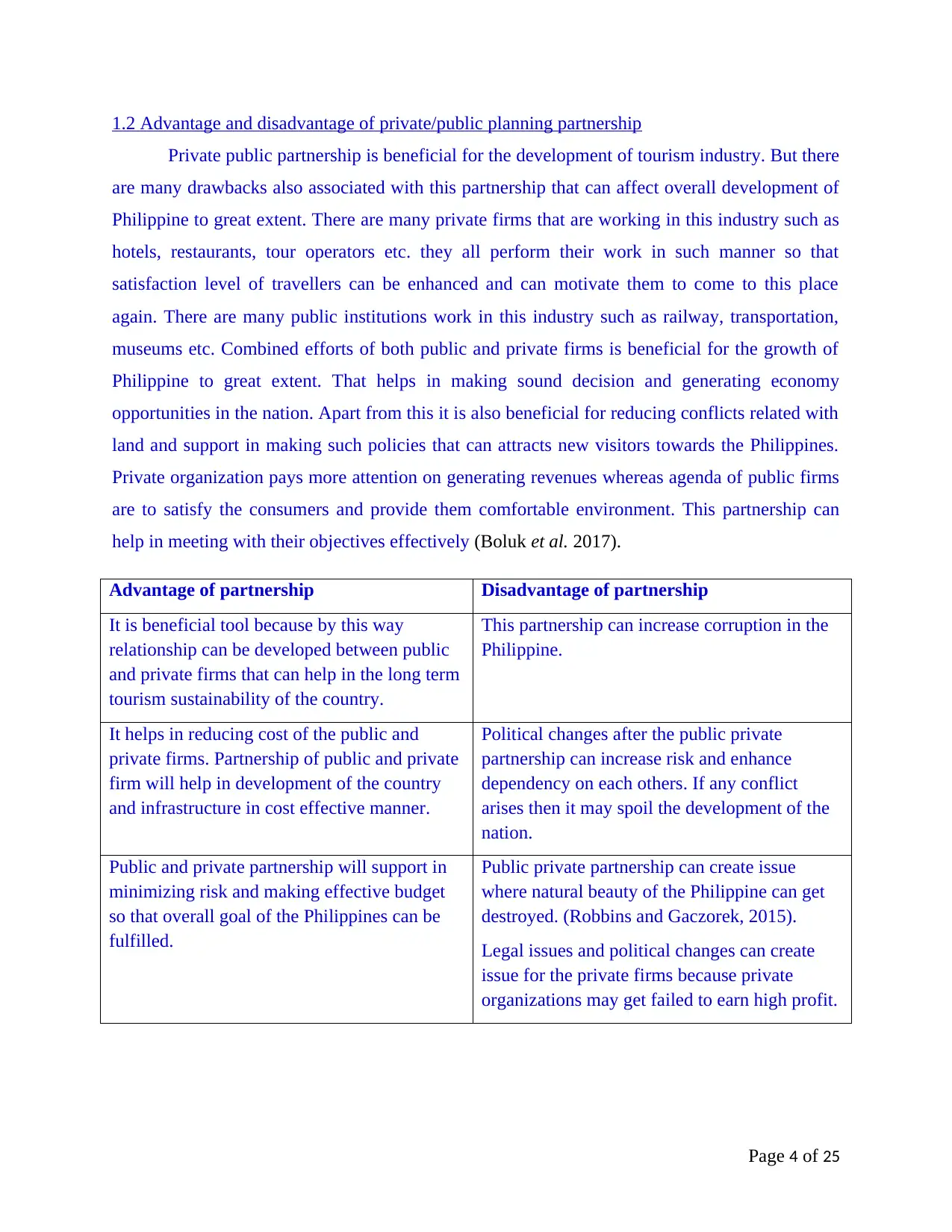
1.2 Advantage and disadvantage of private/public planning partnership
Private public partnership is beneficial for the development of tourism industry. But there
are many drawbacks also associated with this partnership that can affect overall development of
Philippine to great extent. There are many private firms that are working in this industry such as
hotels, restaurants, tour operators etc. they all perform their work in such manner so that
satisfaction level of travellers can be enhanced and can motivate them to come to this place
again. There are many public institutions work in this industry such as railway, transportation,
museums etc. Combined efforts of both public and private firms is beneficial for the growth of
Philippine to great extent. That helps in making sound decision and generating economy
opportunities in the nation. Apart from this it is also beneficial for reducing conflicts related with
land and support in making such policies that can attracts new visitors towards the Philippines.
Private organization pays more attention on generating revenues whereas agenda of public firms
are to satisfy the consumers and provide them comfortable environment. This partnership can
help in meeting with their objectives effectively (Boluk et al. 2017).
Advantage of partnership Disadvantage of partnership
It is beneficial tool because by this way
relationship can be developed between public
and private firms that can help in the long term
tourism sustainability of the country.
This partnership can increase corruption in the
Philippine.
It helps in reducing cost of the public and
private firms. Partnership of public and private
firm will help in development of the country
and infrastructure in cost effective manner.
Political changes after the public private
partnership can increase risk and enhance
dependency on each others. If any conflict
arises then it may spoil the development of the
nation.
Public and private partnership will support in
minimizing risk and making effective budget
so that overall goal of the Philippines can be
fulfilled.
Public private partnership can create issue
where natural beauty of the Philippine can get
destroyed. (Robbins and Gaczorek, 2015).
Legal issues and political changes can create
issue for the private firms because private
organizations may get failed to earn high profit.
Page 4 of 25
Private public partnership is beneficial for the development of tourism industry. But there
are many drawbacks also associated with this partnership that can affect overall development of
Philippine to great extent. There are many private firms that are working in this industry such as
hotels, restaurants, tour operators etc. they all perform their work in such manner so that
satisfaction level of travellers can be enhanced and can motivate them to come to this place
again. There are many public institutions work in this industry such as railway, transportation,
museums etc. Combined efforts of both public and private firms is beneficial for the growth of
Philippine to great extent. That helps in making sound decision and generating economy
opportunities in the nation. Apart from this it is also beneficial for reducing conflicts related with
land and support in making such policies that can attracts new visitors towards the Philippines.
Private organization pays more attention on generating revenues whereas agenda of public firms
are to satisfy the consumers and provide them comfortable environment. This partnership can
help in meeting with their objectives effectively (Boluk et al. 2017).
Advantage of partnership Disadvantage of partnership
It is beneficial tool because by this way
relationship can be developed between public
and private firms that can help in the long term
tourism sustainability of the country.
This partnership can increase corruption in the
Philippine.
It helps in reducing cost of the public and
private firms. Partnership of public and private
firm will help in development of the country
and infrastructure in cost effective manner.
Political changes after the public private
partnership can increase risk and enhance
dependency on each others. If any conflict
arises then it may spoil the development of the
nation.
Public and private partnership will support in
minimizing risk and making effective budget
so that overall goal of the Philippines can be
fulfilled.
Public private partnership can create issue
where natural beauty of the Philippine can get
destroyed. (Robbins and Gaczorek, 2015).
Legal issues and political changes can create
issue for the private firms because private
organizations may get failed to earn high profit.
Page 4 of 25
Paraphrase This Document
Need a fresh take? Get an instant paraphrase of this document with our AI Paraphraser
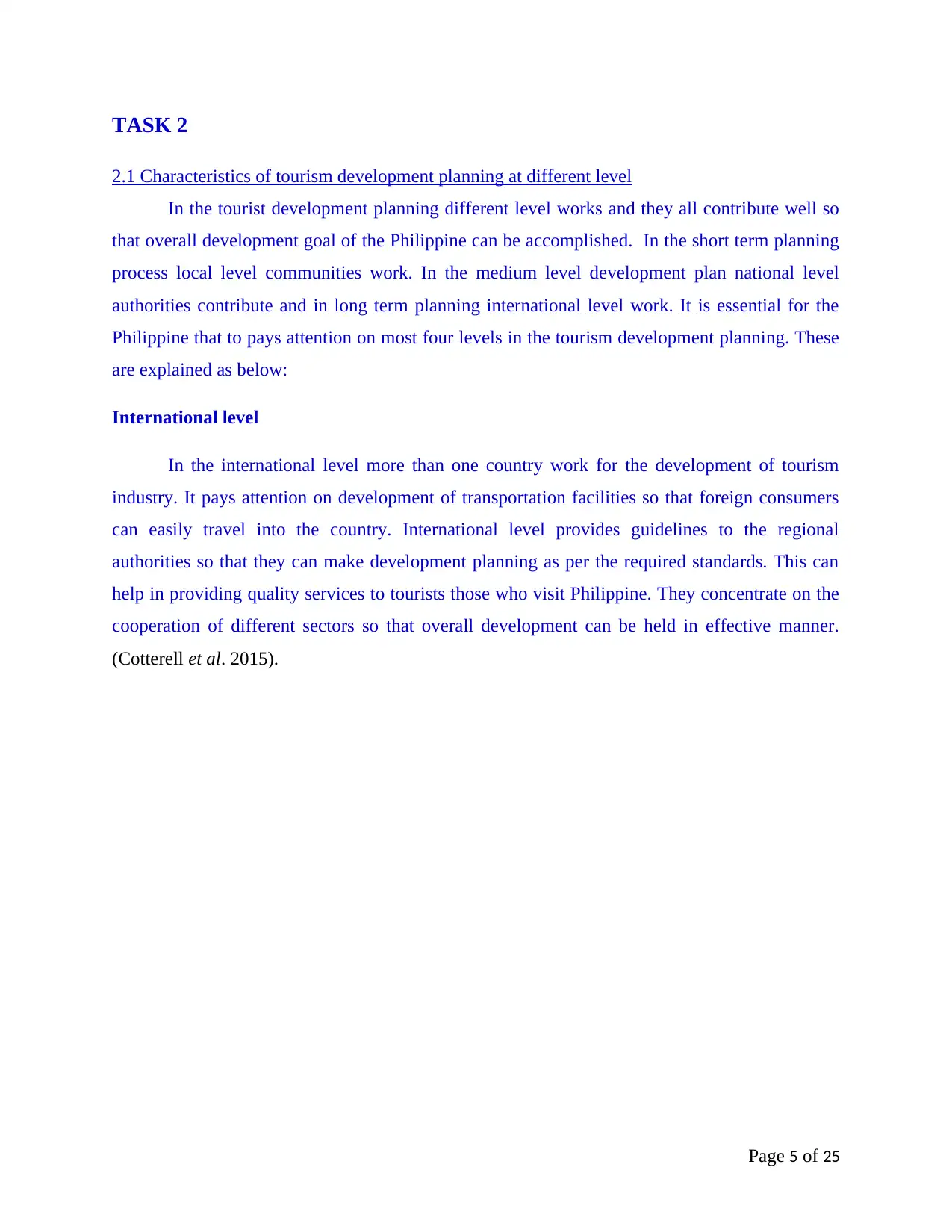
TASK 2
2.1 Characteristics of tourism development planning at different level
In the tourist development planning different level works and they all contribute well so
that overall development goal of the Philippine can be accomplished. In the short term planning
process local level communities work. In the medium level development plan national level
authorities contribute and in long term planning international level work. It is essential for the
Philippine that to pays attention on most four levels in the tourism development planning. These
are explained as below:
International level
In the international level more than one country work for the development of tourism
industry. It pays attention on development of transportation facilities so that foreign consumers
can easily travel into the country. International level provides guidelines to the regional
authorities so that they can make development planning as per the required standards. This can
help in providing quality services to tourists those who visit Philippine. They concentrate on the
cooperation of different sectors so that overall development can be held in effective manner.
(Cotterell et al. 2015).
Page 5 of 25
2.1 Characteristics of tourism development planning at different level
In the tourist development planning different level works and they all contribute well so
that overall development goal of the Philippine can be accomplished. In the short term planning
process local level communities work. In the medium level development plan national level
authorities contribute and in long term planning international level work. It is essential for the
Philippine that to pays attention on most four levels in the tourism development planning. These
are explained as below:
International level
In the international level more than one country work for the development of tourism
industry. It pays attention on development of transportation facilities so that foreign consumers
can easily travel into the country. International level provides guidelines to the regional
authorities so that they can make development planning as per the required standards. This can
help in providing quality services to tourists those who visit Philippine. They concentrate on the
cooperation of different sectors so that overall development can be held in effective manner.
(Cotterell et al. 2015).
Page 5 of 25
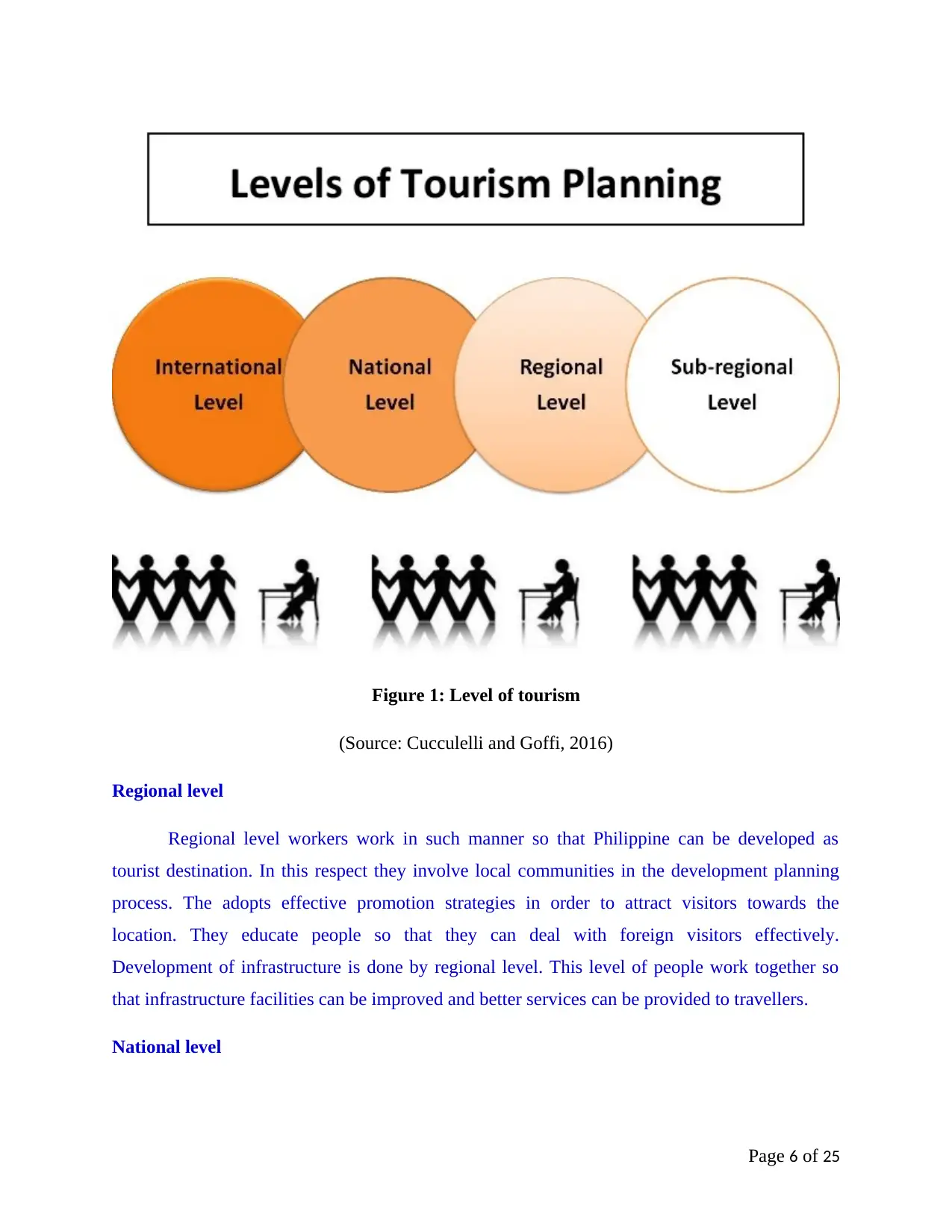
Figure 1: Level of tourism
(Source: Cucculelli and Goffi, 2016)
Regional level
Regional level workers work in such manner so that Philippine can be developed as
tourist destination. In this respect they involve local communities in the development planning
process. The adopts effective promotion strategies in order to attract visitors towards the
location. They educate people so that they can deal with foreign visitors effectively.
Development of infrastructure is done by regional level. This level of people work together so
that infrastructure facilities can be improved and better services can be provided to travellers.
National level
Page 6 of 25
(Source: Cucculelli and Goffi, 2016)
Regional level
Regional level workers work in such manner so that Philippine can be developed as
tourist destination. In this respect they involve local communities in the development planning
process. The adopts effective promotion strategies in order to attract visitors towards the
location. They educate people so that they can deal with foreign visitors effectively.
Development of infrastructure is done by regional level. This level of people work together so
that infrastructure facilities can be improved and better services can be provided to travellers.
National level
Page 6 of 25
⊘ This is a preview!⊘
Do you want full access?
Subscribe today to unlock all pages.

Trusted by 1+ million students worldwide
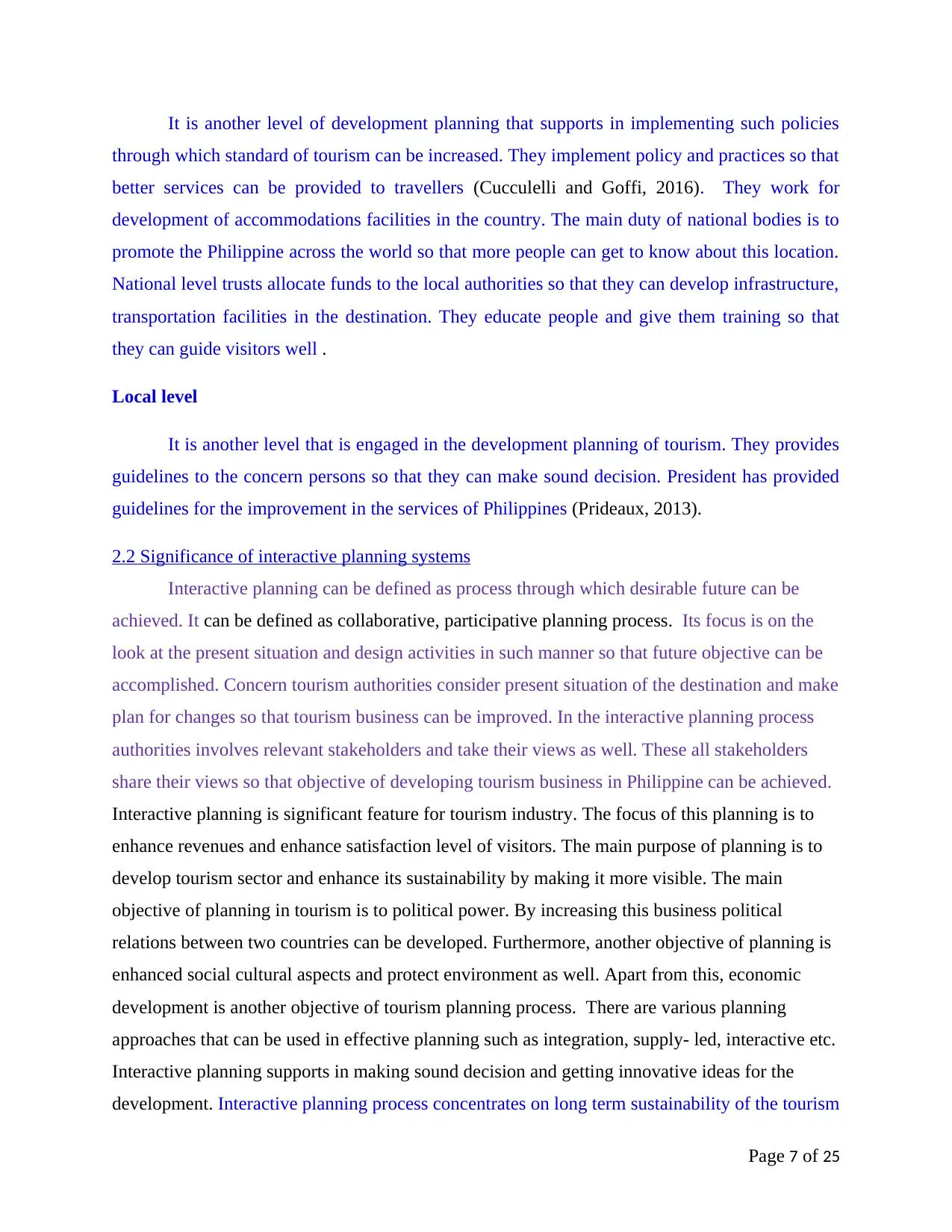
It is another level of development planning that supports in implementing such policies
through which standard of tourism can be increased. They implement policy and practices so that
better services can be provided to travellers (Cucculelli and Goffi, 2016). They work for
development of accommodations facilities in the country. The main duty of national bodies is to
promote the Philippine across the world so that more people can get to know about this location.
National level trusts allocate funds to the local authorities so that they can develop infrastructure,
transportation facilities in the destination. They educate people and give them training so that
they can guide visitors well .
Local level
It is another level that is engaged in the development planning of tourism. They provides
guidelines to the concern persons so that they can make sound decision. President has provided
guidelines for the improvement in the services of Philippines (Prideaux, 2013).
2.2 Significance of interactive planning systems
Interactive planning can be defined as process through which desirable future can be
achieved. It can be defined as collaborative, participative planning process. Its focus is on the
look at the present situation and design activities in such manner so that future objective can be
accomplished. Concern tourism authorities consider present situation of the destination and make
plan for changes so that tourism business can be improved. In the interactive planning process
authorities involves relevant stakeholders and take their views as well. These all stakeholders
share their views so that objective of developing tourism business in Philippine can be achieved.
Interactive planning is significant feature for tourism industry. The focus of this planning is to
enhance revenues and enhance satisfaction level of visitors. The main purpose of planning is to
develop tourism sector and enhance its sustainability by making it more visible. The main
objective of planning in tourism is to political power. By increasing this business political
relations between two countries can be developed. Furthermore, another objective of planning is
enhanced social cultural aspects and protect environment as well. Apart from this, economic
development is another objective of tourism planning process. There are various planning
approaches that can be used in effective planning such as integration, supply- led, interactive etc.
Interactive planning supports in making sound decision and getting innovative ideas for the
development. Interactive planning process concentrates on long term sustainability of the tourism
Page 7 of 25
through which standard of tourism can be increased. They implement policy and practices so that
better services can be provided to travellers (Cucculelli and Goffi, 2016). They work for
development of accommodations facilities in the country. The main duty of national bodies is to
promote the Philippine across the world so that more people can get to know about this location.
National level trusts allocate funds to the local authorities so that they can develop infrastructure,
transportation facilities in the destination. They educate people and give them training so that
they can guide visitors well .
Local level
It is another level that is engaged in the development planning of tourism. They provides
guidelines to the concern persons so that they can make sound decision. President has provided
guidelines for the improvement in the services of Philippines (Prideaux, 2013).
2.2 Significance of interactive planning systems
Interactive planning can be defined as process through which desirable future can be
achieved. It can be defined as collaborative, participative planning process. Its focus is on the
look at the present situation and design activities in such manner so that future objective can be
accomplished. Concern tourism authorities consider present situation of the destination and make
plan for changes so that tourism business can be improved. In the interactive planning process
authorities involves relevant stakeholders and take their views as well. These all stakeholders
share their views so that objective of developing tourism business in Philippine can be achieved.
Interactive planning is significant feature for tourism industry. The focus of this planning is to
enhance revenues and enhance satisfaction level of visitors. The main purpose of planning is to
develop tourism sector and enhance its sustainability by making it more visible. The main
objective of planning in tourism is to political power. By increasing this business political
relations between two countries can be developed. Furthermore, another objective of planning is
enhanced social cultural aspects and protect environment as well. Apart from this, economic
development is another objective of tourism planning process. There are various planning
approaches that can be used in effective planning such as integration, supply- led, interactive etc.
Interactive planning supports in making sound decision and getting innovative ideas for the
development. Interactive planning process concentrates on long term sustainability of the tourism
Page 7 of 25
Paraphrase This Document
Need a fresh take? Get an instant paraphrase of this document with our AI Paraphraser
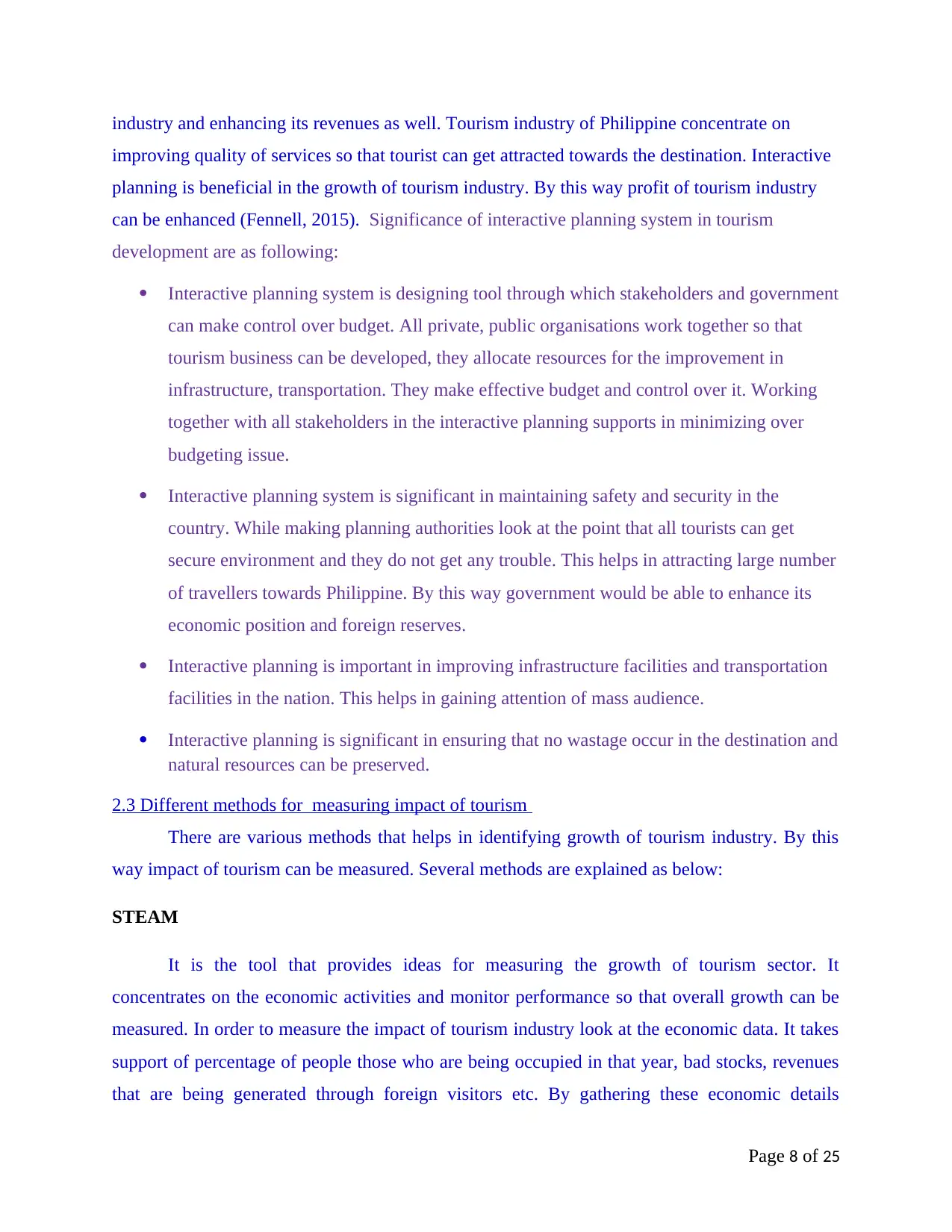
industry and enhancing its revenues as well. Tourism industry of Philippine concentrate on
improving quality of services so that tourist can get attracted towards the destination. Interactive
planning is beneficial in the growth of tourism industry. By this way profit of tourism industry
can be enhanced (Fennell, 2015). Significance of interactive planning system in tourism
development are as following:
Interactive planning system is designing tool through which stakeholders and government
can make control over budget. All private, public organisations work together so that
tourism business can be developed, they allocate resources for the improvement in
infrastructure, transportation. They make effective budget and control over it. Working
together with all stakeholders in the interactive planning supports in minimizing over
budgeting issue.
Interactive planning system is significant in maintaining safety and security in the
country. While making planning authorities look at the point that all tourists can get
secure environment and they do not get any trouble. This helps in attracting large number
of travellers towards Philippine. By this way government would be able to enhance its
economic position and foreign reserves.
Interactive planning is important in improving infrastructure facilities and transportation
facilities in the nation. This helps in gaining attention of mass audience.
Interactive planning is significant in ensuring that no wastage occur in the destination and
natural resources can be preserved.
2.3 Different methods for measuring impact of tourism
There are various methods that helps in identifying growth of tourism industry. By this
way impact of tourism can be measured. Several methods are explained as below:
STEAM
It is the tool that provides ideas for measuring the growth of tourism sector. It
concentrates on the economic activities and monitor performance so that overall growth can be
measured. In order to measure the impact of tourism industry look at the economic data. It takes
support of percentage of people those who are being occupied in that year, bad stocks, revenues
that are being generated through foreign visitors etc. By gathering these economic details
Page 8 of 25
improving quality of services so that tourist can get attracted towards the destination. Interactive
planning is beneficial in the growth of tourism industry. By this way profit of tourism industry
can be enhanced (Fennell, 2015). Significance of interactive planning system in tourism
development are as following:
Interactive planning system is designing tool through which stakeholders and government
can make control over budget. All private, public organisations work together so that
tourism business can be developed, they allocate resources for the improvement in
infrastructure, transportation. They make effective budget and control over it. Working
together with all stakeholders in the interactive planning supports in minimizing over
budgeting issue.
Interactive planning system is significant in maintaining safety and security in the
country. While making planning authorities look at the point that all tourists can get
secure environment and they do not get any trouble. This helps in attracting large number
of travellers towards Philippine. By this way government would be able to enhance its
economic position and foreign reserves.
Interactive planning is important in improving infrastructure facilities and transportation
facilities in the nation. This helps in gaining attention of mass audience.
Interactive planning is significant in ensuring that no wastage occur in the destination and
natural resources can be preserved.
2.3 Different methods for measuring impact of tourism
There are various methods that helps in identifying growth of tourism industry. By this
way impact of tourism can be measured. Several methods are explained as below:
STEAM
It is the tool that provides ideas for measuring the growth of tourism sector. It
concentrates on the economic activities and monitor performance so that overall growth can be
measured. In order to measure the impact of tourism industry look at the economic data. It takes
support of percentage of people those who are being occupied in that year, bad stocks, revenues
that are being generated through foreign visitors etc. By gathering these economic details
Page 8 of 25
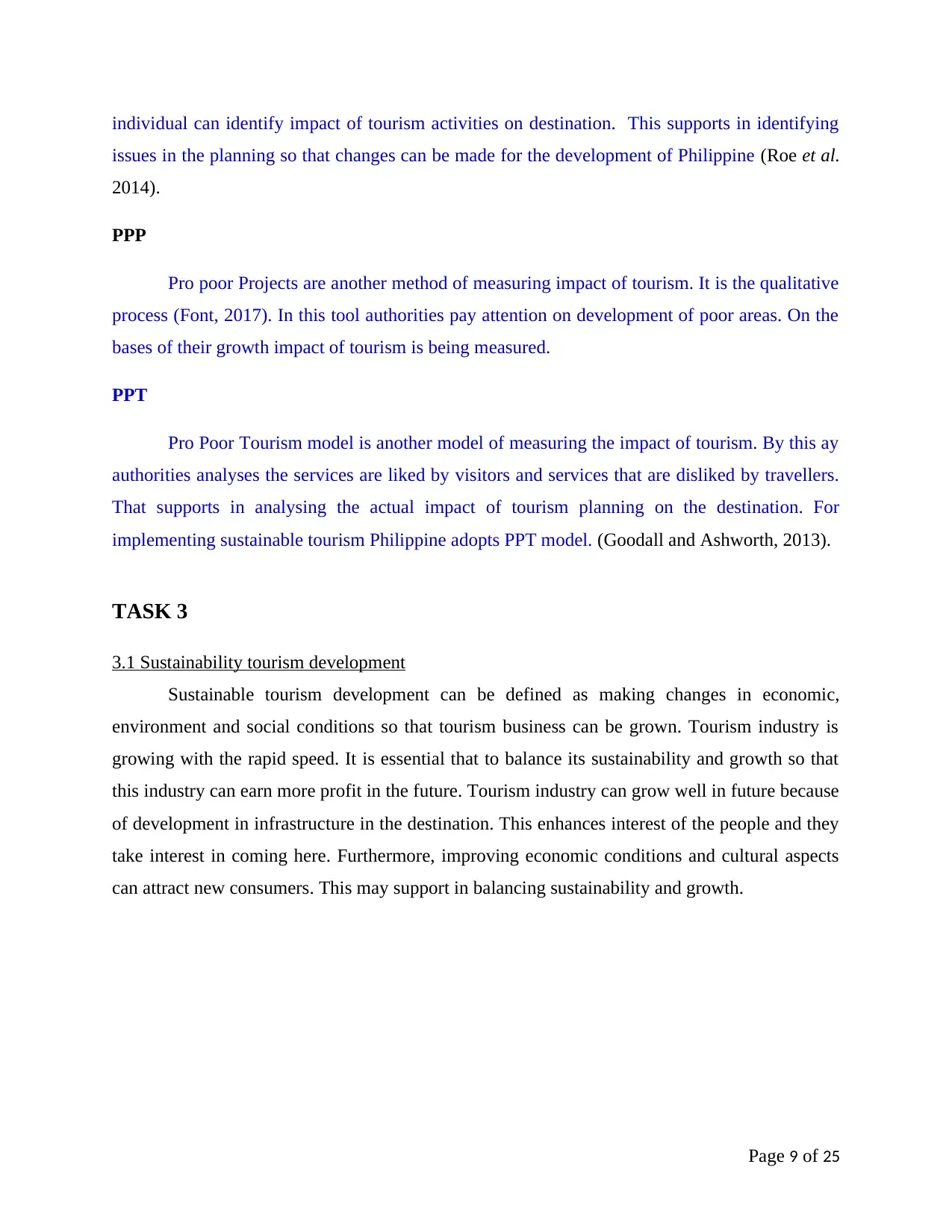
individual can identify impact of tourism activities on destination. This supports in identifying
issues in the planning so that changes can be made for the development of Philippine (Roe et al.
2014).
PPP
Pro poor Projects are another method of measuring impact of tourism. It is the qualitative
process (Font, 2017). In this tool authorities pay attention on development of poor areas. On the
bases of their growth impact of tourism is being measured.
PPT
Pro Poor Tourism model is another model of measuring the impact of tourism. By this ay
authorities analyses the services are liked by visitors and services that are disliked by travellers.
That supports in analysing the actual impact of tourism planning on the destination. For
implementing sustainable tourism Philippine adopts PPT model. (Goodall and Ashworth, 2013).
TASK 3
3.1 Sustainability tourism development
Sustainable tourism development can be defined as making changes in economic,
environment and social conditions so that tourism business can be grown. Tourism industry is
growing with the rapid speed. It is essential that to balance its sustainability and growth so that
this industry can earn more profit in the future. Tourism industry can grow well in future because
of development in infrastructure in the destination. This enhances interest of the people and they
take interest in coming here. Furthermore, improving economic conditions and cultural aspects
can attract new consumers. This may support in balancing sustainability and growth.
Page 9 of 25
issues in the planning so that changes can be made for the development of Philippine (Roe et al.
2014).
PPP
Pro poor Projects are another method of measuring impact of tourism. It is the qualitative
process (Font, 2017). In this tool authorities pay attention on development of poor areas. On the
bases of their growth impact of tourism is being measured.
PPT
Pro Poor Tourism model is another model of measuring the impact of tourism. By this ay
authorities analyses the services are liked by visitors and services that are disliked by travellers.
That supports in analysing the actual impact of tourism planning on the destination. For
implementing sustainable tourism Philippine adopts PPT model. (Goodall and Ashworth, 2013).
TASK 3
3.1 Sustainability tourism development
Sustainable tourism development can be defined as making changes in economic,
environment and social conditions so that tourism business can be grown. Tourism industry is
growing with the rapid speed. It is essential that to balance its sustainability and growth so that
this industry can earn more profit in the future. Tourism industry can grow well in future because
of development in infrastructure in the destination. This enhances interest of the people and they
take interest in coming here. Furthermore, improving economic conditions and cultural aspects
can attract new consumers. This may support in balancing sustainability and growth.
Page 9 of 25
⊘ This is a preview!⊘
Do you want full access?
Subscribe today to unlock all pages.

Trusted by 1+ million students worldwide
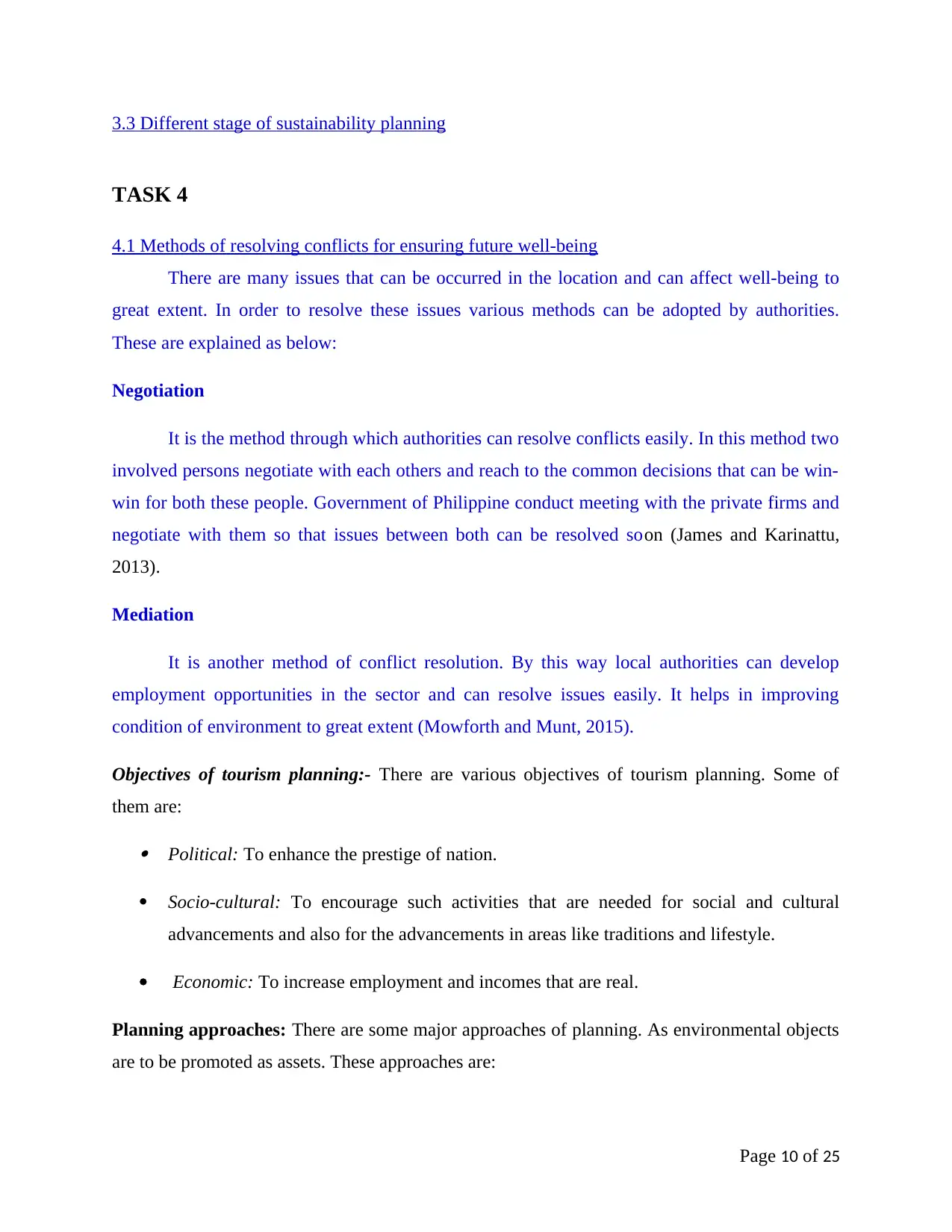
3.3 Different stage of sustainability planning
TASK 4
4.1 Methods of resolving conflicts for ensuring future well-being
There are many issues that can be occurred in the location and can affect well-being to
great extent. In order to resolve these issues various methods can be adopted by authorities.
These are explained as below:
Negotiation
It is the method through which authorities can resolve conflicts easily. In this method two
involved persons negotiate with each others and reach to the common decisions that can be win-
win for both these people. Government of Philippine conduct meeting with the private firms and
negotiate with them so that issues between both can be resolved soon (James and Karinattu,
2013).
Mediation
It is another method of conflict resolution. By this way local authorities can develop
employment opportunities in the sector and can resolve issues easily. It helps in improving
condition of environment to great extent (Mowforth and Munt, 2015).
Objectives of tourism planning:- There are various objectives of tourism planning. Some of
them are:
Political: To enhance the prestige of nation.
Socio-cultural: To encourage such activities that are needed for social and cultural
advancements and also for the advancements in areas like traditions and lifestyle.
Economic: To increase employment and incomes that are real.
Planning approaches: There are some major approaches of planning. As environmental objects
are to be promoted as assets. These approaches are:
Page 10 of 25
TASK 4
4.1 Methods of resolving conflicts for ensuring future well-being
There are many issues that can be occurred in the location and can affect well-being to
great extent. In order to resolve these issues various methods can be adopted by authorities.
These are explained as below:
Negotiation
It is the method through which authorities can resolve conflicts easily. In this method two
involved persons negotiate with each others and reach to the common decisions that can be win-
win for both these people. Government of Philippine conduct meeting with the private firms and
negotiate with them so that issues between both can be resolved soon (James and Karinattu,
2013).
Mediation
It is another method of conflict resolution. By this way local authorities can develop
employment opportunities in the sector and can resolve issues easily. It helps in improving
condition of environment to great extent (Mowforth and Munt, 2015).
Objectives of tourism planning:- There are various objectives of tourism planning. Some of
them are:
Political: To enhance the prestige of nation.
Socio-cultural: To encourage such activities that are needed for social and cultural
advancements and also for the advancements in areas like traditions and lifestyle.
Economic: To increase employment and incomes that are real.
Planning approaches: There are some major approaches of planning. As environmental objects
are to be promoted as assets. These approaches are:
Page 10 of 25
Paraphrase This Document
Need a fresh take? Get an instant paraphrase of this document with our AI Paraphraser
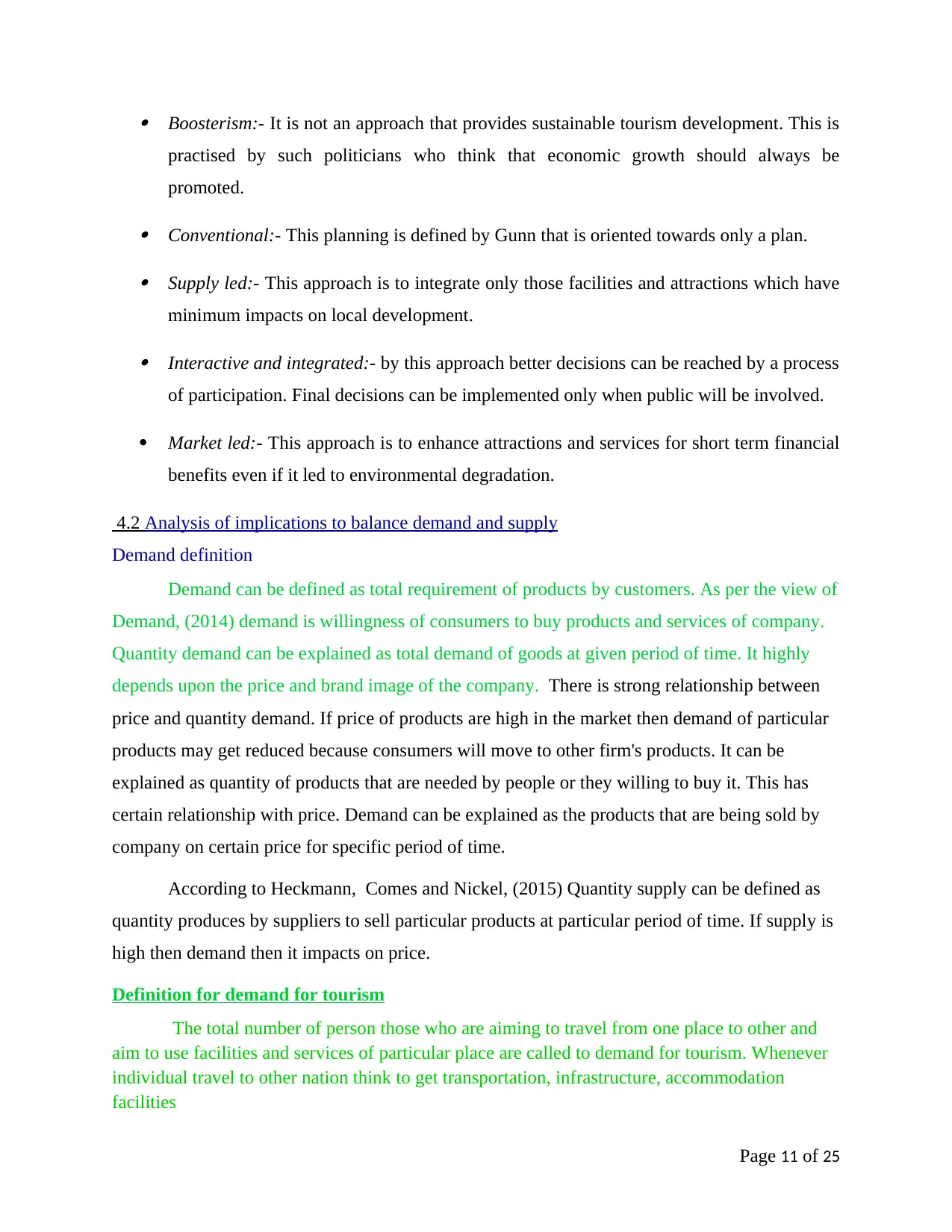
Boosterism:- It is not an approach that provides sustainable tourism development. This is
practised by such politicians who think that economic growth should always be
promoted.
Conventional:- This planning is defined by Gunn that is oriented towards only a plan.
Supply led:- This approach is to integrate only those facilities and attractions which have
minimum impacts on local development.
Interactive and integrated:- by this approach better decisions can be reached by a process
of participation. Final decisions can be implemented only when public will be involved.
Market led:- This approach is to enhance attractions and services for short term financial
benefits even if it led to environmental degradation.
4.2 Analysis of implications to balance demand and supply
Demand definition
Demand can be defined as total requirement of products by customers. As per the view of
Demand, (2014) demand is willingness of consumers to buy products and services of company.
Quantity demand can be explained as total demand of goods at given period of time. It highly
depends upon the price and brand image of the company. There is strong relationship between
price and quantity demand. If price of products are high in the market then demand of particular
products may get reduced because consumers will move to other firm's products. It can be
explained as quantity of products that are needed by people or they willing to buy it. This has
certain relationship with price. Demand can be explained as the products that are being sold by
company on certain price for specific period of time.
According to Heckmann, Comes and Nickel, (2015) Quantity supply can be defined as
quantity produces by suppliers to sell particular products at particular period of time. If supply is
high then demand then it impacts on price.
Definition for demand for tourism
The total number of person those who are aiming to travel from one place to other and
aim to use facilities and services of particular place are called to demand for tourism. Whenever
individual travel to other nation think to get transportation, infrastructure, accommodation
facilities
Page 11 of 25
practised by such politicians who think that economic growth should always be
promoted.
Conventional:- This planning is defined by Gunn that is oriented towards only a plan.
Supply led:- This approach is to integrate only those facilities and attractions which have
minimum impacts on local development.
Interactive and integrated:- by this approach better decisions can be reached by a process
of participation. Final decisions can be implemented only when public will be involved.
Market led:- This approach is to enhance attractions and services for short term financial
benefits even if it led to environmental degradation.
4.2 Analysis of implications to balance demand and supply
Demand definition
Demand can be defined as total requirement of products by customers. As per the view of
Demand, (2014) demand is willingness of consumers to buy products and services of company.
Quantity demand can be explained as total demand of goods at given period of time. It highly
depends upon the price and brand image of the company. There is strong relationship between
price and quantity demand. If price of products are high in the market then demand of particular
products may get reduced because consumers will move to other firm's products. It can be
explained as quantity of products that are needed by people or they willing to buy it. This has
certain relationship with price. Demand can be explained as the products that are being sold by
company on certain price for specific period of time.
According to Heckmann, Comes and Nickel, (2015) Quantity supply can be defined as
quantity produces by suppliers to sell particular products at particular period of time. If supply is
high then demand then it impacts on price.
Definition for demand for tourism
The total number of person those who are aiming to travel from one place to other and
aim to use facilities and services of particular place are called to demand for tourism. Whenever
individual travel to other nation think to get transportation, infrastructure, accommodation
facilities
Page 11 of 25
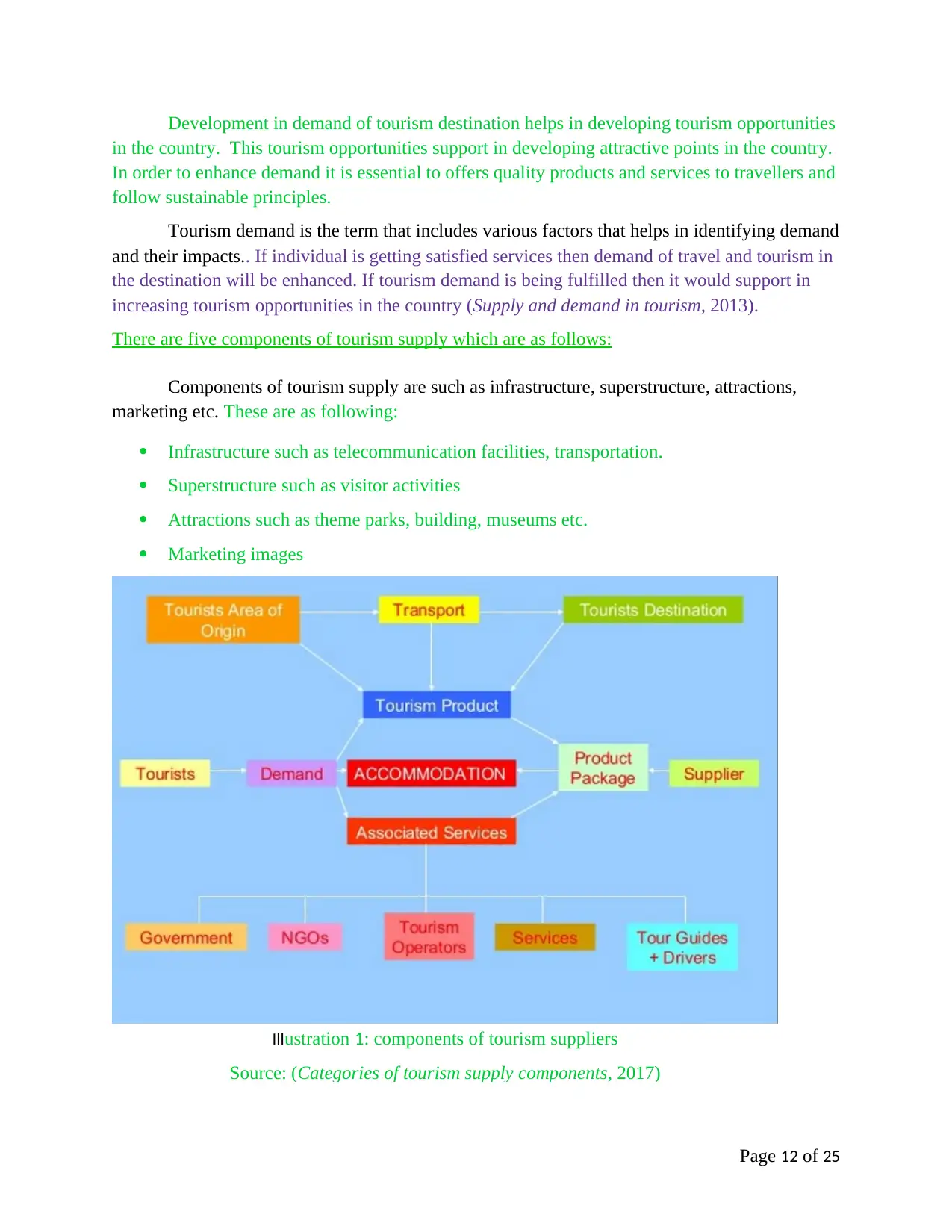
Development in demand of tourism destination helps in developing tourism opportunities
in the country. This tourism opportunities support in developing attractive points in the country.
In order to enhance demand it is essential to offers quality products and services to travellers and
follow sustainable principles.
Tourism demand is the term that includes various factors that helps in identifying demand
and their impacts.. If individual is getting satisfied services then demand of travel and tourism in
the destination will be enhanced. If tourism demand is being fulfilled then it would support in
increasing tourism opportunities in the country (Supply and demand in tourism, 2013).
There are five components of tourism supply which are as follows:
Components of tourism supply are such as infrastructure, superstructure, attractions,
marketing etc. These are as following:
Infrastructure such as telecommunication facilities, transportation.
Superstructure such as visitor activities
Attractions such as theme parks, building, museums etc.
Marketing images
Illustration 1: components of tourism suppliers
Source: (Categories of tourism supply components, 2017)
Page 12 of 25
in the country. This tourism opportunities support in developing attractive points in the country.
In order to enhance demand it is essential to offers quality products and services to travellers and
follow sustainable principles.
Tourism demand is the term that includes various factors that helps in identifying demand
and their impacts.. If individual is getting satisfied services then demand of travel and tourism in
the destination will be enhanced. If tourism demand is being fulfilled then it would support in
increasing tourism opportunities in the country (Supply and demand in tourism, 2013).
There are five components of tourism supply which are as follows:
Components of tourism supply are such as infrastructure, superstructure, attractions,
marketing etc. These are as following:
Infrastructure such as telecommunication facilities, transportation.
Superstructure such as visitor activities
Attractions such as theme parks, building, museums etc.
Marketing images
Illustration 1: components of tourism suppliers
Source: (Categories of tourism supply components, 2017)
Page 12 of 25
⊘ This is a preview!⊘
Do you want full access?
Subscribe today to unlock all pages.

Trusted by 1+ million students worldwide
1 out of 25
Related Documents
Your All-in-One AI-Powered Toolkit for Academic Success.
+13062052269
info@desklib.com
Available 24*7 on WhatsApp / Email
![[object Object]](/_next/static/media/star-bottom.7253800d.svg)
Unlock your academic potential
Copyright © 2020–2025 A2Z Services. All Rights Reserved. Developed and managed by ZUCOL.





